The Intel Haswell-E CPU Review: Core i7-5960X, i7-5930K and i7-5820K Tested
by Ian Cutress on August 29, 2014 12:00 PM ESTCPU Benchmarks
The dynamics of CPU Turbo modes, with both Intel and AMD, can cause concern during environments with a variable threaded workload. There is also an added issue of the motherboard remaining consistent, depending on how the motherboard manufacturer wants to add in their own boosting technologies over the ones that the CPU manufacturer would prefer they used. In order to remain consistent, we implement an OS-level unique high performance mode on all the CPUs we test which should override any motherboard manufacturer performance mode.
HandBrake v0.9.9: link
For HandBrake, we take two videos (a 2h20 640x266 DVD rip and a 10min double UHD 3840x4320 animation short) and convert them to x264 format in an MP4 container. Results are given in terms of the frames per second processed, and HandBrake uses as many threads as possible.
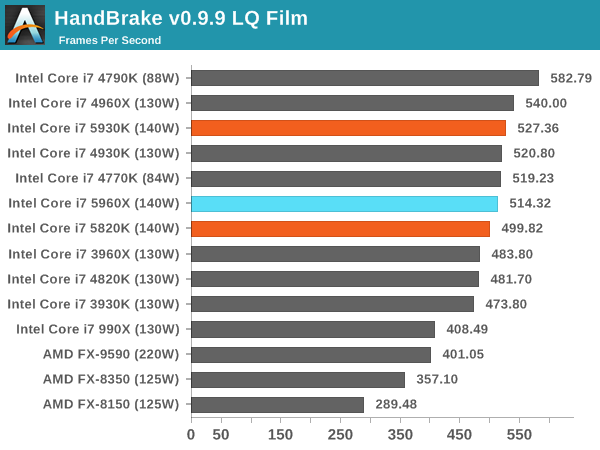
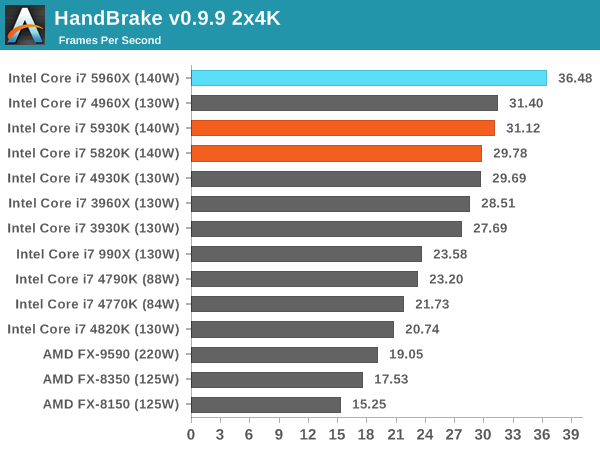
The variable turbo speeds of the CPUs results in a small difference in low quality conversion, and the high single core frequency of the 4790K wins there. For 4K conversion the problem becomes more parallel and the extra cores of the 5960X push it ahead of the pack. The 5930K and 5820K are both behind the 4960X however.
Agisoft Photoscan – 2D to 3D Image Manipulation: link
Agisoft Photoscan creates 3D models from 2D images, a process which is very computationally expensive. The algorithm is split into four distinct phases, and different phases of the model reconstruction require either fast memory, fast IPC, more cores, or even OpenCL compute devices to hand. Agisoft supplied us with a special version of the software to script the process, where we take 50 images of a stately home and convert it into a medium quality model. This benchmark typically takes around 15-20 minutes on a high end PC on the CPU alone, with GPUs reducing the time.
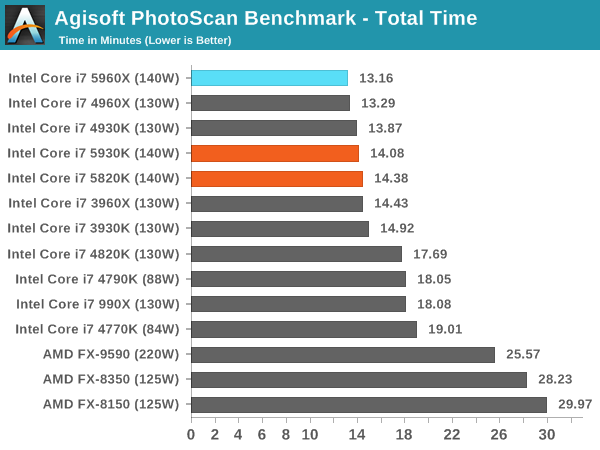
Photoscan's four separate components rely on different amounts of high frequency vs. many cores: check our Bench database for more detailed results but overall the 5960X comes out on top. That being said, the 5820K is less than 40% of the price and is only 1.2 minutes behind.
Dolphin Benchmark: link
Many emulators are often bound by single thread CPU performance, and general reports tended to suggest that Haswell provided a significant boost to emulator performance. This benchmark runs a Wii program that raytraces a complex 3D scene inside the Dolphin Wii emulator. Performance on this benchmark is a good proxy of the speed of Dolphin CPU emulation, which is an intensive single core task using most aspects of a CPU. Results are given in minutes, where the Wii itself scores 17.53 minutes.
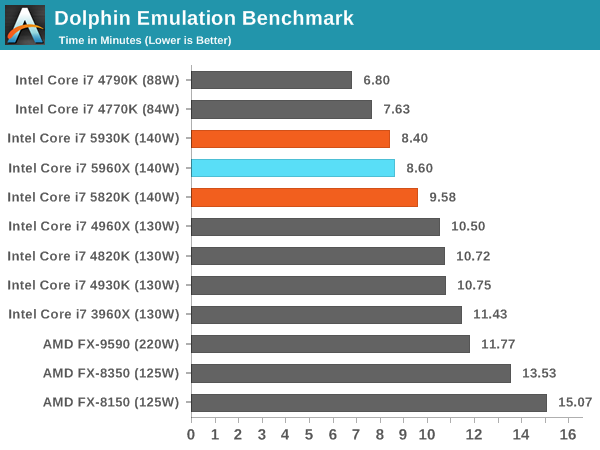
Dolphon loves single core speed and efficiency, meaning the 4790K wins out again. Interestingly the large L3 cache of the 5960X also helps here against the 5820K, despite the 5820K having a higher single thread frequency.
WinRAR 5.0.1: link
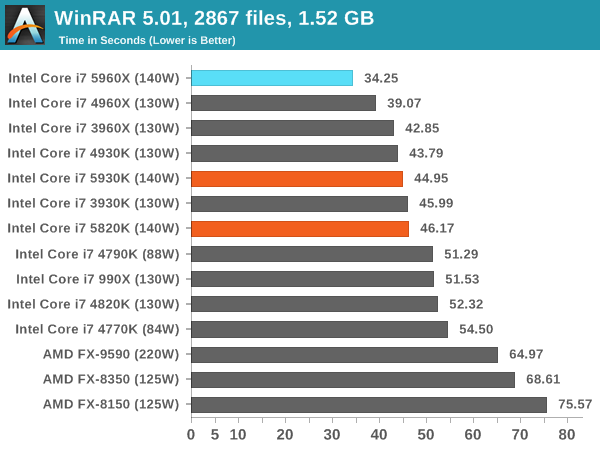
WinRAR is a variable thread workload, but more cores still wins out. Interestingly the xx60X CPUs are ahead of the xx30K CPUs followed by the xx20K. After this comes the 4790K, and then the 990X on par, showing how far three generations of Intel CPU have developed.
PCMark8 v2 OpenCL
A new addition to our CPU testing suite is PCMark8 v2, where we test the Work 2.0 and Creative 3.0 suites in OpenCL mode.
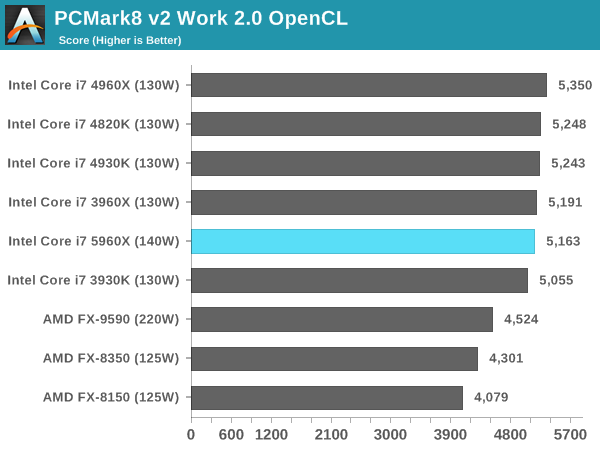
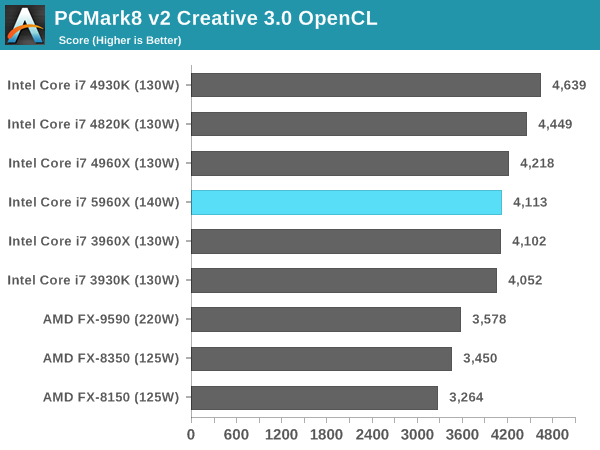
PCMark v8 relies on a number of factors, and it would seem that frequency is preferred over cache and memory. Interestingly the 4930K beat the 4960X in the Creative Suite with no obvious explanation.
Hybrid x265: link
Hybrid is a new benchmark, where we take a 4K 1500 frame video and convert it into an x265 format without audio. Results are given in frames per second.

Converting 4K video gets another step in the preference for more cores in Hybrid x265. The 5820K matches the 3960X, showing the progression of CPU generational development.
Cinebench R15
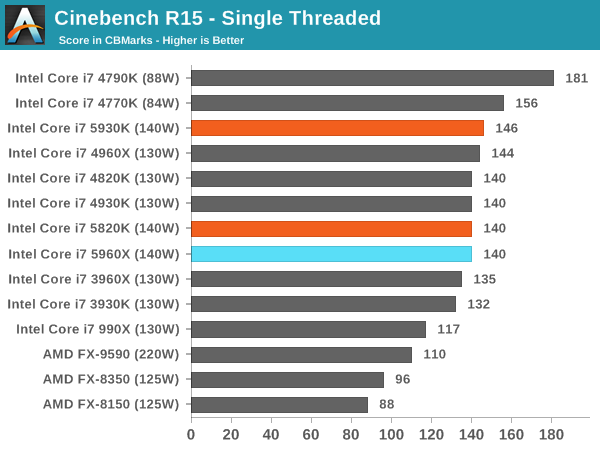
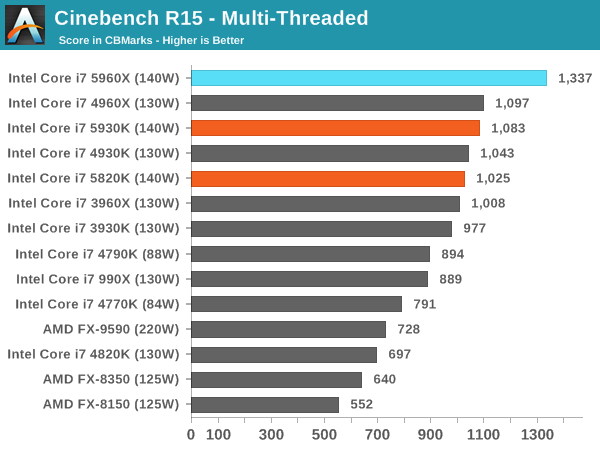
3D Particle Movement
3DPM is a self-penned benchmark, taking basic 3D movement algorithms used in Brownian Motion simulations and testing them for speed. High floating point performance, MHz and IPC wins in the single thread version, whereas the multithread version has to handle the threads and loves more cores.
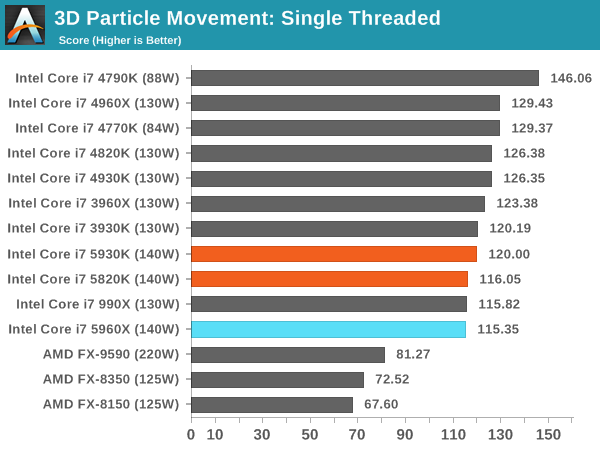

FastStone Image Viewer 4.9
FastStone is the program I use to perform quick or bulk actions on images, such as resizing, adjusting for color and cropping. In our test we take a series of 170 images in various sizes and formats and convert them all into 640x480 .gif files, maintaining the aspect ratio. FastStone does not use multithreading for this test, and results are given in seconds.
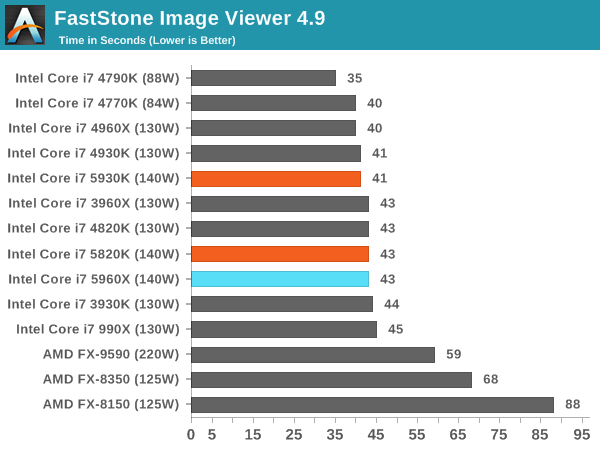
FastStone is a purely single threaded exercise, showing here how the lower core CPUs with high turbo perfom best, and by quite a margin.










203 Comments
View All Comments
ol1bit - Tuesday, September 2, 2014 - link
You would think since intel seems stuck at a specific design speed for the most part(other than die shrink) that AMD could come up with a better architecture. Maybe there is no better architecture out there?coachingjoy - Tuesday, September 2, 2014 - link
ha, in three years we have 10-15% performance increase.
willis936 - Tuesday, September 2, 2014 - link
Since those parts are nearly identically clocked with a cost per core core being so low you're really getting about a 280% increase in performance per dollar over three years. Compared to other market segments that have practically stalled out everywhere in x86 land yes it is pretty amazing.LemmingOverlord - Tuesday, September 2, 2014 - link
about the gaming benchmarks, core count doesn't really make a difference in most of your chosen games... however there are still a few good CPU-benchmark games that come to mind, Civ V and the Supreme Commander series, to mention a couple. In fact I'd keep an eye out for Planetary Annihilation. It's avalilable this weekend, although I'm pretty sure Uber Entertainment would hand one over just for benchmarking.Gonemad - Tuesday, September 2, 2014 - link
"now the lowest end CPU for the extreme Intel platform". Yep, I'm just using an i7-920, that was exactly at the same spot in its day. Same architecture and memory as the extreme flagship, at a fraction of the cost. Not counting server chips, right?Intel Core i7-5820K, you say eh? Hmm... maybe I should write that down for later... Except I'm not planning anything beyond 1080p, then all of these chips and cards are a bit overkill.
Correction: I want full pedal-to-the-metal at 1080p, perhaps the "average build" should help... right? I appreciate anybody pitching in on the details for a machine to run anything at 1080p (or 1920x1200 actually) at 60 fps, but not more.
azazel1024 - Tuesday, September 2, 2014 - link
I'd like to add what is the most interesting to me is the 5820k. Hexacore cheap (Intel Hexacore, which IMHO is the only kind that matters). I'll likely never have the budget for a $1000 chip and then the system to do it justice.However I currently have an i5-3570 OC to 4GHz. Cost something like $380 for processor and board at the time. For what appears to be around $600 I could now get 50% more cores, hyperthreading and probably be able to reliably OC to a "consevative" 4.2GHz for probably >60% performance improvement for less than half again the cost.
In comparison to moving up to the i7-4770k, which would only cost maybe $50 or so less, with a modest performance improvement (probably only 15-30%).
It does make me VERY interested in Broadwell-E and Skylake-E, as those are the most likely points at which I might be looking at an upgrade. I do wonder if Skylake-E will see entry level Enthusiast Octocore, and maybe even if it'll mean high end mainstream Skylake Hexacore.
That would be an interesting decision if 6 or 8 core processors were not terribly far off in price.
Nfarce - Wednesday, September 3, 2014 - link
"However I currently have an i5-3570 OC to 4GHz. Cost something like $380 for processor and board at the time. For what appears to be around $600 I could now get 50% more cores, hyperthreading and probably be able to reliably OC to a "consevative" 4.2GHz for probably >60% performance improvement for less than half again the cost."Dude, did you forget about the cost of having to buy DDR4 memory modules? That will throw your numbers out the window.
BLOODYHELL - Thursday, September 4, 2014 - link
WHAT DO YOU GUYS THINK FOR LARGE FILE VIDEO EDITING? MMA FIGHTING ETC. ADOBE PREMIRE CS6, VEGAS?BLOODYHELL - Thursday, September 4, 2014 - link
What do you guys think for large video editing MMA FIGHTS, WEDDINGS? Trying to save time editing and rendering videos.naxeem - Thursday, September 4, 2014 - link
Well, since Broadwell is not out yet, I doubt we'll see SkyLake that soon...